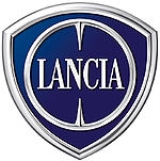
Lancia
Encyclopedia
Lancia Automobiles S.p.A. (ˈlantʃa) is an Italian
automobile manufacturer founded in 1906 by Vincenzo Lancia
and which became part of the Fiat Group
in 1969. The company has a long history of producing distinctive cars and also has a strong rally heritage. Some modern Lancias are seen as presenting a more luxurious alternative to the models in the Fiat range upon which they are based. One of the firm's trademarks is the use of letters of the Greek alphabet
as the names of its models.
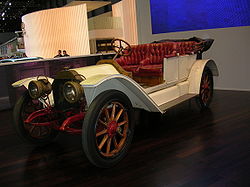
by Vincenzo Lancia
and his friend Claudio Fogolin, both being Fiat racing drivers, as Lancia & C. The first Lancia automobile the "tipo 51
" or 12 HP (later called Alfa) was made in 1907 and produced from 1908. This car had a small four cylinder engine with a power of 58 bhp. In 1937 Vincenzo died of a heart attack, and his wife Adele Miglietti Lancia and his son Gianni Lancia
took over the firm. They persuaded Vittorio Jano
to join Lancia as an engineer. Jano had already made a name for himself by constructing the Alfa Romeo 1750 Sport Alfa Romeo 6C
, 2300, 2900, P2 Alfa Romeo P2
and P3 Alfa Romeo P3
, some of the most successful racers of its time.
Lancia is famous for many automotive innovations. These include the 1913 Theta
, which was the first production car in Europe to feature a complete electrical system as standard equipment. The first car with a monocoque
-type body – the Lambda
, produced from 1922 to 1931 also featured 'Sliding Pillar' independent front suspension that incorporated the spring and hydraulic damper into a single unit (and featured on most production Lancias until the Appia was replaced in 1963). 1948 saw the first 5 speed gearbox to be fitted to a production car (Series 3 Ardea). Lancia premiered the first full-production V6 engine
, in the 1950 Aurelia
, after earlier industry-leading experiments with V8
and V12 engine
configurations. It was also the first company to produce a V4 engine
. Also, Lancia pioneered the use of independent suspension
in production cars, in an era where live axle
s were common practice for both the front and rear axles of a car. They also developed rear transaxles which were fitted to the Aurelia and Flaminia ranges. The innovativeness, constant quest for excellence, the fixation of quality, the complication of the construction processes and the antiqued machinery meant that all cars essentially had to be hand-made. With little commonality between the various models, the cost of production continued to increase extensively, while demand did not.
. The logo shows a lance and shield with flag. The
Turin automobile museum
is named after him as Museo Nazionale dell'Automobile “Carlo Biscaretti di Ruffia”. The logo was redesigned in 2007.
, and new models in the 1970s such as the Stratos
, Gamma
and Beta
served to prove that Fiat
wished to preserve the image of the brand it had acquired.
During the 1980s, the company cooperated with Saab Automobile
, with the Lancia Delta
being sold as the Saab 600
in Sweden
. The 1985 Lancia Thema
also shared a platform with the Saab 9000
, Fiat Croma
and the Alfa Romeo 164
.
produced from 2011, It is based on a updated Fiat 500 platform.
produced since 2004 in two series, the Musa is largely based on the Fiat Idea
.
models.
The Lancia Aurelia
introduced the front engine rear transmission configuration later used by Ferrari, Alfa Romeo, Porsche, GM, and Maserati, as well as the V6 engine, which is now common. It also had inboard rear brakes
, an important way of reducing un-sprung weight.
The Lancia Stratos
was a successful rally car during the 1970s and helped the company to improve its sporting credentials.
to be named Flavia
, a luxury saloon/sedan based on the Chrysler 300
called Lancia Thema
and a minivan based on the Chrysler Town & Country called Voyager.
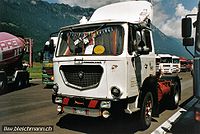

from 1975. Sales were comparatively slow and the range was withdrawn at the same time as Fiat in 1982.
In 2009, following Fiat's acquisition of a stake in United States-based Chrysler
and part of Chrysler's restructuring plans, it was stated that Fiat plans for the Chrysler brand and Lancia to codevelop products, with some vehicles being shared. Olivier Francois, Lancia's CEO, took over as CEO of the Chrysler
division in October 2009. Fiat has also stated that, depending on the market, some Chrysler cars will be sold as Lancias and vice versa. Francois plans to reestablish the Chrysler brand as an upscale brand, a position somewhat muddied after the Plymouth
brand was discontinued. At the 2010 Detroit Auto Show, a Chrysler-badged Lancia Delta
was on display, likely the first Lancia to be sold as a Chrysler and possibly as a replacement for the Chrysler PT Cruiser
.
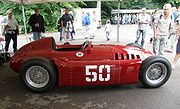 After Vincenzo Lancia's son Gianni
After Vincenzo Lancia's son Gianni
became director of the firm, it started to take part more frequently in motorsport, eventually deciding to build a Grand Prix car. Vittorio Jano
was the new designer for Lancia and his Lancia D50
was entered into the 1954 Spanish Grand Prix
, where Alberto Ascari
took the pole position and drove the fastest lap. In the 1955 Monaco Grand Prix
Ascari crashed into the harbour after missing a chicane. One week later Ascari was killed in an accident driving a Ferrari sports car at Monza. With Ascari's death and Lancia's financial problems the company withdrew from Grand Prix racing. Altogether Lancia took two victories and ten podiums in Formula One.
Remnants of the Lancia team were transferred to Scuderia Ferrari
, where Juan Manuel Fangio
won the 1956 championship
with a Lancia-Ferrari car.
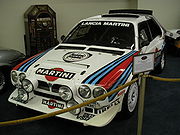 Lancia has been very successful in motorsport over the years, and mostly in the arena of rallying
Lancia has been very successful in motorsport over the years, and mostly in the arena of rallying
. Prior to the forming of the World Rally Championship
, Lancia took the final International Championship for Manufacturers
title with the Fulvia
in 1972. In the WRC, they remain the most statistically successful marque (despite having withdrawn at the end of the 1993 season), winning constructors' titles with the Stratos
(1974, 1975 and 1976), the 037
(1983) and the Delta
(six consecutive wins from 1987
to 1992). The Delta is also the most successful individual model designation ever to compete in rallying. All this gave Lancia a total of 10 Championships over the years.
Juha Kankkunen
and Miki Biasion both won two drivers' titles with the Delta. Among other drivers to take several World Rally Championship wins with Lancia were Markku Alén
, Didier Auriol
, Sandro Munari
, Bernard Darniche
, Walter Röhrl
, Björn Waldegård
and Henri Toivonen
. The history of the brand in rallying is also tainted with tragedy, with deaths of Italian driver Attilio Bettega
at the 1985 Tour de Corse
in a Lancia 037
and then Finnish championship favourite Toivonen in a Lancia Delta S4
at the same rally exactly a year later. These deaths would eventually lead to the end of Group B
rallying.
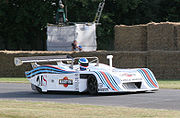 During Lancia's dominance of rallying, company also expanded into sports cars in the late 1970s until the mid-1980s. Originally running the Stratos HF
During Lancia's dominance of rallying, company also expanded into sports cars in the late 1970s until the mid-1980s. Originally running the Stratos HF
in Group 4
, as well as a brief interlude with a rare Group 5
version, the car was replaced with the Monte Carlo
Turbo. In 1982 the team moved up to Group 6 with the LC1
Spyder, followed by the Group C
LC2
coupé which featured a Ferrari
powerplant in 1983. The LC2 was a match for the standard-setting Porsche 956
in terms of raw speed, securing 13 pole positions over its lifetime, however its results were hampered by poor reliability and fuel economy
and it only managed to win three European and World Endurance Championship races. The team's inability to compete against the dominant Porsche 956
and 962
sports cars led it to drop out of sportscar racing at the end of 1986 in order to concentrate on rallying, although private teams continued to enter LC2s with declining results until the early 1990s.
, Fulvia Coupé
, Aprilia
, Beta Montecarlo, Beta Coupé, HPE, Stratos
, 037
, Delta Integrale and Thema 8.32. They also stated during their review that Lancia made the best looking cars, even though they are unreliable.
Italy
Italy , officially the Italian Republic languages]] under the European Charter for Regional or Minority Languages. In each of these, Italy's official name is as follows:;;;;;;;;), is a unitary parliamentary republic in South-Central Europe. To the north it borders France, Switzerland, Austria and...
automobile manufacturer founded in 1906 by Vincenzo Lancia
Vincenzo Lancia
Vincenzo Lancia was an Italian pilot, engineer and founder of Lancia.Vincenzo Lancia was born in the small village of Fobello on 24 August 1881, close to Turin...
and which became part of the Fiat Group
Fiat
FIAT, an acronym for Fabbrica Italiana Automobili Torino , is an Italian automobile manufacturer, engine manufacturer, financial, and industrial group based in Turin in the Italian region of Piedmont. Fiat was founded in 1899 by a group of investors including Giovanni Agnelli...
in 1969. The company has a long history of producing distinctive cars and also has a strong rally heritage. Some modern Lancias are seen as presenting a more luxurious alternative to the models in the Fiat range upon which they are based. One of the firm's trademarks is the use of letters of the Greek alphabet
Greek alphabet
The Greek alphabet is the script that has been used to write the Greek language since at least 730 BC . The alphabet in its classical and modern form consists of 24 letters ordered in sequence from alpha to omega...
as the names of its models.
History

| Year | Cars |
|---|---|
| 1998 | 175 215 |
| 1999 | 161 019 |
| 2000 | 170,348 |
| 2001 | 134,812 |
| 2002 | 110,529 |
| 2003 | 108,989 |
| 2004 | 118,201 |
| 2005 | 115,543 |
| 2006 | 122,956 |
| 2007 | 118,036 |
| 2008 | 113,307 |
| 2009 | 113,810 |
| 2010 | 97,757 |
Foundation and early years
Lancia was founded on 29 November 1906 in TurinTurin
Turin is a city and major business and cultural centre in northern Italy, capital of the Piedmont region, located mainly on the left bank of the Po River and surrounded by the Alpine arch. The population of the city proper is 909,193 while the population of the urban area is estimated by Eurostat...
by Vincenzo Lancia
Vincenzo Lancia
Vincenzo Lancia was an Italian pilot, engineer and founder of Lancia.Vincenzo Lancia was born in the small village of Fobello on 24 August 1881, close to Turin...
and his friend Claudio Fogolin, both being Fiat racing drivers, as Lancia & C. The first Lancia automobile the "tipo 51
Lancia Alfa-12HP
The Lancia Alfa 12 HP was the first car made by Lancia. The cars first road tests begun in September 1907 and production started in 1908. Vincenzo Lancia unveiled his first car in Turin Motor Show in 1908...
" or 12 HP (later called Alfa) was made in 1907 and produced from 1908. This car had a small four cylinder engine with a power of 58 bhp. In 1937 Vincenzo died of a heart attack, and his wife Adele Miglietti Lancia and his son Gianni Lancia
Gianni Lancia
Gianni Lancia is an Italian former automobile engineer, industrialist and racing enthusiast, known for running the Lancia carmaker in Torino...
took over the firm. They persuaded Vittorio Jano
Vittorio Jano
Vittorio Jano was an Italian automobile designer of Hungarian descent from the 1920s through 1960s.Jano was born Viktor János in San Giorgio Canavese, in Piedmont, to Hungarian immigrants, who arrived there several years before the birth of Jano. He began his career at the car and truck company...
to join Lancia as an engineer. Jano had already made a name for himself by constructing the Alfa Romeo 1750 Sport Alfa Romeo 6C
Alfa Romeo 6C
The Alfa Romeo 6C name was used on road, race and sports cars made between 1925–1954 by Alfa Romeo. 6C refers to a straight 6 engine. Bodies for these cars were made by coachbuilders such as James Young, Zagato, Touring, Castagna, and Pininfarina...
, 2300, 2900, P2 Alfa Romeo P2
Alfa Romeo P2
The Alfa Romeo P2 won the inaugural Automobile World Championship in 1925, taking victory in two of the four championship rounds when Antonio Ascari drove it in the European Grand Prix at Spa and Gastone Brilli-Peri won the Italian Grand Prix at Monza after Ascari died while leading the intervening...
and P3 Alfa Romeo P3
Alfa Romeo P3
The Alfa Romeo P3, P3 monoposto or Tipo B was a classic Grand Prix car designed by Vittorio Jano, one of the Alfa Romeo 8C models. The P3 was first genuine single-seat Grand Prix racing car and Alfa Romeo's second monoposto after Tipo A monoposto . It was based on the earlier successful Alfa Romeo P2...
, some of the most successful racers of its time.
Lancia is famous for many automotive innovations. These include the 1913 Theta
Lancia Theta-35HP
The Lancia Theta is a car which was produced between 1913-1918 by Lancia. The car was bigger version of Epsilon model.The car had electrical lights and start motor....
, which was the first production car in Europe to feature a complete electrical system as standard equipment. The first car with a monocoque
Monocoque
Monocoque is a construction technique that supports structural load by using an object's external skin, as opposed to using an internal frame or truss that is then covered with a non-load-bearing skin or coachwork...
-type body – the Lambda
Lancia Lambda
The Lancia Lambda is an innovative automobile produced from 1922 through 1931. It was the first car to feature a load-bearing monocoque-type body, and it also pioneered the use of an independent suspension . Vincenzo Lancia even invented a shock absorber for the car and it had excellent four wheel...
, produced from 1922 to 1931 also featured 'Sliding Pillar' independent front suspension that incorporated the spring and hydraulic damper into a single unit (and featured on most production Lancias until the Appia was replaced in 1963). 1948 saw the first 5 speed gearbox to be fitted to a production car (Series 3 Ardea). Lancia premiered the first full-production V6 engine
V6 engine
A V6 engine is a V engine with six cylinders mounted on the crankcase in two banks of three cylinders, usually set at either a right angle or an acute angle to each other, with all six pistons driving a common crankshaft...
, in the 1950 Aurelia
Lancia Aurelia
The Lancia Aurelia is a car that was produced by the Italian manufacturer Lancia. Designed by Vittorio Jano, the Aurelia was launched in 1950 and production lasted until the summer of 1958....
, after earlier industry-leading experiments with V8
V8 engine
A V8 engine is a V engine with eight cylinders mounted on the crankcase in two banks of four cylinders, in most cases set at a right angle to each other but sometimes at a narrower angle, with all eight pistons driving a common crankshaft....
and V12 engine
V12 engine
A V12 engine is a V engine with 12 cylinders mounted on the crankcase in two banks of six cylinders, usually but not always at a 60° angle to each other, with all 12 pistons driving a common crankshaft....
configurations. It was also the first company to produce a V4 engine
V4 engine
A V4 engine is a V form engine with four cylinders and three main bearings.-Automobile use:Lancia produced several narrow-angle V4 engines from the 1920s through 1960s for cars like the Lambda, Augusta, Artena, Aprilia, Ardea, Appia, and Fulvia....
. Also, Lancia pioneered the use of independent suspension
Independent suspension
Independent suspension is a broad term for any automobile suspension system that allows each wheel on the same axle to move vertically independently of each other. This is contrasted with a beam axle, live axle or deDion axle system in which the wheels are linked – movement on one side affects...
in production cars, in an era where live axle
Live axle
A live axle, sometimes called a solid axle, is a type of beam axle suspension system that uses the driveshafts that transmit power to the wheels to connect the wheels laterally so that they move together as a unit....
s were common practice for both the front and rear axles of a car. They also developed rear transaxles which were fitted to the Aurelia and Flaminia ranges. The innovativeness, constant quest for excellence, the fixation of quality, the complication of the construction processes and the antiqued machinery meant that all cars essentially had to be hand-made. With little commonality between the various models, the cost of production continued to increase extensively, while demand did not.
Logo
The original Lancia logo was designed by Count Carlo Biscaretti di RuffiaCarlo Biscaretti di Ruffia
Carlo Biscaretti di Ruffia was an Italian conte, known for his works as artist, industrial designer, journalist and as automobile enthusiast....
. The logo shows a lance and shield with flag. The
Turin automobile museum
Museo Nazionale dell'Automobile
The Museo Nazionale dell'Automobile , named after Carlo Biscaretti di Ruffia, is an automobile museum in Turin, northern Italy. The collection has around eighty automobile brands representing eight countries...
is named after him as Museo Nazionale dell'Automobile “Carlo Biscaretti di Ruffia”. The logo was redesigned in 2007.
Association with other manufacturers
Lancia was not closely associated with any other manufacturer until the late 1960s. By this time, the company's expensive, high standards of production had become unsustainable. In aiming to produce a product of the highest quality, company bosses had sacrificed cost-effectiveness and when Fiat launched a take-over bid in 1969, they accepted. This was not the end of the distinctive Lancia brandBrand
The American Marketing Association defines a brand as a "Name, term, design, symbol, or any other feature that identifies one seller's good or service as distinct from those of other sellers."...
, and new models in the 1970s such as the Stratos
Lancia Stratos
The Lancia Stratos HF, widely and more simply known as Lancia Stratos, is a car made by Italian car manufacturer Lancia. The HF stands for High Fidelity...
, Gamma
Lancia Gamma
The Lancia Gamma is an executive car from Italian Fiat Auto's up-scale Lancia marque. Presented in 1976 at the Geneva Motor Show as Lancia's new flagship, it filled the void in Lancia's lineup left by the demise of the Flavia...
and Beta
Lancia Beta
The Lancia Beta is a car produced by Lancia. It was the first new model introduced by Lancia after it had been taken over by Fiat in 1969.-Berlina:...
served to prove that Fiat
Fiat
FIAT, an acronym for Fabbrica Italiana Automobili Torino , is an Italian automobile manufacturer, engine manufacturer, financial, and industrial group based in Turin in the Italian region of Piedmont. Fiat was founded in 1899 by a group of investors including Giovanni Agnelli...
wished to preserve the image of the brand it had acquired.
During the 1980s, the company cooperated with Saab Automobile
Saab Automobile
Saab Automobile AB, better known as Saab , is a Swedish car manufacturer owned by Dutch automobile manufacturer Swedish Automobile NV, formerly Spyker Cars NV. It is the exclusive automobile Royal Warrant holder as appointed by the King of Sweden...
, with the Lancia Delta
Lancia Delta
The Lancia Delta is a small family car produced by Italian automaker Lancia with the first generation being produced between 1979 and 1994, the second generation running from 1993 until 1999, and the third generation Delta entering production in 2008. It was first shown inFrankfurt Motor Show in 1979...
being sold as the Saab 600
Saab 600
The Saab-Lancia 600 is a rebadged Lancia Delta, sold by Saab after a deal with Lancia.The deal was a part of the 1980s co-operation between the Swedish car manufacturer Saab and the Italian Fiat Group, which includes Lancia and Alfa Romeo in addition to Fiat...
in Sweden
Sweden
Sweden , officially the Kingdom of Sweden , is a Nordic country on the Scandinavian Peninsula in Northern Europe. Sweden borders with Norway and Finland and is connected to Denmark by a bridge-tunnel across the Öresund....
. The 1985 Lancia Thema
Lancia Thema
The Lancia Thema is an executive car produced by the Italian automaker Lancia between 1984 and 1994, and one of four cars to share the Type Four platform alongside the Alfa Romeo 164, Fiat Croma and Saab 9000...
also shared a platform with the Saab 9000
Saab 9000
The Saab 9000 is an automobile that was produced by the Swedish company Saab from 1984 to 1997. The 9000 was replaced by the 9-5 in the late 1997....
, Fiat Croma
Fiat Croma
The Fiat Croma is a nameplate used for two automobiles produced by Italian automaker Fiat, one a large family car built from 1985 to 1996 and the other a cross-over wagon built from 2005 to 2011.- Fiat Croma :...
and the Alfa Romeo 164
Alfa Romeo 164
The Alfa Romeo 164 is an executive car with saloon body, produced by the Italian automaker Alfa Romeo from 1987 to 1998.The 164 was re-badged as the 168 for the Hong Kong and Malaysian markets, as the number "164" had a very negative connotation , and "168" has quite the opposite The Alfa Romeo 164...
.
Current models
| Ypsilon Lancia Ypsilon The Lancia Ypsilon is a supermini produced by Italian automaker Lancia since 1996. It is the replacement of the Y10, although larger and more expensive... |
Musa Lancia Musa The Lancia Musa is a mini MPV marketed by Lancia, the premium marque of Italian automaker Fiat. It is largely based on the Fiat Idea, with which it shares most of the components, but is differentiated by different front and rear ends, as well as interior elements and equipment... |
Delta Lancia Delta The Lancia Delta is a small family car produced by Italian automaker Lancia with the first generation being produced between 1979 and 1994, the second generation running from 1993 until 1999, and the third generation Delta entering production in 2008. It was first shown inFrankfurt Motor Show in 1979... |
Thema | Voyager |
|---|---|---|---|---|
|
|
|
|
|
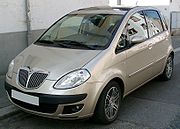 |
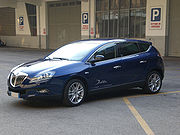 |
Lancia Ypsilon
The Ypsilon is a supermini carSupermini car
A supermini is a British term that describes automobiles larger than a city car but smaller than a small family car. This car class is also known as the B-segment across Europe, and as subcompact in North America....
produced from 2011, It is based on a updated Fiat 500 platform.
Lancia Musa
A small MPVMinivan
Minivan is a type of van designed for personal use. Minivans are typically either two-box or one box designs for maximum interior volume – and are taller than a sedan, hatchback, or a station wagon....
produced since 2004 in two series, the Musa is largely based on the Fiat Idea
Fiat Idea
The Fiat Idea is a mini MPV built by the Italian manufacturer Fiat since 2003. The car is based on the Project 188 platform, originally used for the second-generation Fiat Punto. The Idea is noted for its versatile interior, which includes sliding and folding rear seats...
.
Lancia Delta
A small family car unveiled at the 2008 Geneva motor show. Using stretched version of Fiat C-platform. Available as five-door hatchback. In the UK and Ireland it is sold as the Chrysler Delta.Lancia Thema
An executive car introduced in 2011, based on Chrysler 300Past car models
Lancia has a long tradition of passenger, fast touring, sports and racing cars. They have tended to emphasize quality, appearance and sophisticated design, somewhat at the expense of power and competitive pricing. Among the most beautiful, desirable and unusual models are various Lancia ZagatoLancia Zagato
Various sports and "fast touring" Lancia cars have had bodies built or designed by the great Italian design house Zagato. These include the 1953–60 Lancia Appia Zagato V4 and the 1958–1960s Lancia Flaminia Zagato V6, both with aluminum bodies designed and built by Zagato, and the 1967-1972 Lancia...
models.
The Lancia Aurelia
Lancia Aurelia
The Lancia Aurelia is a car that was produced by the Italian manufacturer Lancia. Designed by Vittorio Jano, the Aurelia was launched in 1950 and production lasted until the summer of 1958....
introduced the front engine rear transmission configuration later used by Ferrari, Alfa Romeo, Porsche, GM, and Maserati, as well as the V6 engine, which is now common. It also had inboard rear brakes
Inboard brake
An inboard braking system is an automobile technology wherein the disk brakes are mounted on the chassis of the vehicle, rather than directly on the wheel hubs...
, an important way of reducing un-sprung weight.
The Lancia Stratos
Lancia Stratos
The Lancia Stratos HF, widely and more simply known as Lancia Stratos, is a car made by Italian car manufacturer Lancia. The HF stands for High Fidelity...
was a successful rally car during the 1970s and helped the company to improve its sporting credentials.
Future models
At the 2011 Geneva Motor Show, three new Lancia vehicles were introduced, all based on Chrysler platforms. They include a car and convertible based on the new Chrysler 200Chrysler 200
The Chrysler 200 is a mid-size sedan and convertible produced by Chrysler, being introduced for the 2011 model year. The Chrysler 200 is an update and new nameplate for the outgoing 2010 Chrysler Sebring....
to be named Flavia
Lancia Flavia
The Lancia Flavia is a medium sized luxury saloon, launched with a 1500 cc engine at the 1960 Turin Motor Show by Lancia and introduced in major European markets during the next twelve months. Coupe and cabriolet versions developed by Pininfarina quickly followed, together with one or two low...
, a luxury saloon/sedan based on the Chrysler 300
Chrysler 300
The Chrysler 300 is a full-size upscale car first shown at the 2003 New York Auto Show as a concept car. Sales in the U.S. began in the spring of 2004 as an early 2005 model year car. Designed by Ralph Gilles, the new 300 was built as a high-end sedan while the SRT-8 model was designed to be the...
called Lancia Thema
Lancia Thema
The Lancia Thema is an executive car produced by the Italian automaker Lancia between 1984 and 1994, and one of four cars to share the Type Four platform alongside the Alfa Romeo 164, Fiat Croma and Saab 9000...
and a minivan based on the Chrysler Town & Country called Voyager.
Light commercial vehicles
- Lancia Beta / Lancia Beta Diesel
- Lancia Jolly
- Lancia Superjolly
Trucks


- Lancia Eta (car with a loading area)
- Lancia Jota (1915)
- Lancia Dijota (1915)
- Lancia Triota (1921)
- Lancia Tetrajota (1921)
- Lancia Pentajota (1924)
- Lancia Esajota
- Lancia Eptajota (1927)
- Lancia Omicron
- Lancia Ro (1932)
- Lancia Ro-Ro (1935)
- Lancia 3Ro (1938)
- Lancia EsaRo (1941)
- Lancia E 290 (1941) single-built electric truck
- Lancia 6Ro (1947)
- Lancia Esatau (1950–1968)
- Lancia Beta / Lancia Beta Diesel
- Lancia Esatau B (1955)
- Lancia Beta Diesel (1959) Lancia Beta 190, with a supercharged twin-cylinder compressor – two stroke – diesel engine
- Lancia Esadelta B (1959)
- Lancia Esadelta C (1969)
Buses
- Lancia Trijota
- Lancia Tetrajota
- Lancia Omicron
- Lancia Ro
- Lancia Esatau
- Lancia Esagamma
Military vehicles
- Lancia IZMLancia IZMThe Lancia IZ and the Lancia IZM were two variations of an Italian armoured car built during World War I and which saw limited service during that war, the interwar period, and during World War II.-Design:...
(1912) armored vehicle - Lancia 3Ro (1939) truck
- Lancia EsaRo (1942) truck
- Lancia Lince (lynx) (1942) armored car – a copy of Daimler DingoDaimler Dingo-external links :*** has a Daimler Dingo in its exposition.* wwiivehicles.com**...
MK I - Lancia 6Ro (1948) LKW
- Lancia CL51 (Z 20) (1954) troop transporter
- Lancia TL51 (Z 30) (1954) lorries
Lancia in the United States
While some models had been imported on a small scale in the 1950s and 1960s, Lancias were officially sold in the United StatesUnited States
The United States of America is a federal constitutional republic comprising fifty states and a federal district...
from 1975. Sales were comparatively slow and the range was withdrawn at the same time as Fiat in 1982.
In 2009, following Fiat's acquisition of a stake in United States-based Chrysler
Chrysler
Chrysler Group LLC is a multinational automaker headquartered in Auburn Hills, Michigan, USA. Chrysler was first organized as the Chrysler Corporation in 1925....
and part of Chrysler's restructuring plans, it was stated that Fiat plans for the Chrysler brand and Lancia to codevelop products, with some vehicles being shared. Olivier Francois, Lancia's CEO, took over as CEO of the Chrysler
Chrysler (division)
Chrysler is the flagship brand of Chrysler Group LLC, named after founder Walter P. Chrysler.-Overview:The Chrysler brand was originally a premium luxury position competing with Cadillac and Lincoln, owned respectively by Chrysler Group's Detroit rivals, General Motors and Ford Motor Company...
division in October 2009. Fiat has also stated that, depending on the market, some Chrysler cars will be sold as Lancias and vice versa. Francois plans to reestablish the Chrysler brand as an upscale brand, a position somewhat muddied after the Plymouth
Plymouth (automobile)
Plymouth was a marque of automobile based in the United States, produced by the Chrysler Corporation and its successor DaimlerChrysler.-Origins:...
brand was discontinued. At the 2010 Detroit Auto Show, a Chrysler-badged Lancia Delta
Lancia Delta
The Lancia Delta is a small family car produced by Italian automaker Lancia with the first generation being produced between 1979 and 1994, the second generation running from 1993 until 1999, and the third generation Delta entering production in 2008. It was first shown inFrankfurt Motor Show in 1979...
was on display, likely the first Lancia to be sold as a Chrysler and possibly as a replacement for the Chrysler PT Cruiser
Chrysler PT Cruiser
The Chrysler PT Cruiser is a retro styled compact automobile launched by Chrysler as a 5-door hatchback in early 2000 and as a 2-door convertible in early 2005 ....
.
Formula One

Gianni Lancia
Gianni Lancia is an Italian former automobile engineer, industrialist and racing enthusiast, known for running the Lancia carmaker in Torino...
became director of the firm, it started to take part more frequently in motorsport, eventually deciding to build a Grand Prix car. Vittorio Jano
Vittorio Jano
Vittorio Jano was an Italian automobile designer of Hungarian descent from the 1920s through 1960s.Jano was born Viktor János in San Giorgio Canavese, in Piedmont, to Hungarian immigrants, who arrived there several years before the birth of Jano. He began his career at the car and truck company...
was the new designer for Lancia and his Lancia D50
Lancia D50
The Lancia D50 was a Formula One racing car designed by Vittorio Jano for Lancia in 1954. The car's design made use of many innovative features, such as the use of the engine as a stressed chassis member, the off-centre positioning of the engine to allow a lower overall height, and pannier fuel...
was entered into the 1954 Spanish Grand Prix
1954 Spanish Grand Prix
The 1954 Spanish Grand Prix was a Formula One motor race held on October 24, 1954 at Pedralbes. It was the ninth and final round of the 1954 World Drivers' Championship.- Race report :...
, where Alberto Ascari
Alberto Ascari
Alberto Ascari was an Italian racing driver and twice Formula One World Champion. He is one of only two Italian Formula One World Champions in the history of the sport, and the only one winning his two championships in a Ferrari....
took the pole position and drove the fastest lap. In the 1955 Monaco Grand Prix
1955 Monaco Grand Prix
The 1955 Monaco Grand Prix was a Formula One motor race held at Monaco on May 22, 1955. It was the second round of the 1955 World Drivers' Championship and was given an honorary name, Grand Prix d'Europe.- Race report :...
Ascari crashed into the harbour after missing a chicane. One week later Ascari was killed in an accident driving a Ferrari sports car at Monza. With Ascari's death and Lancia's financial problems the company withdrew from Grand Prix racing. Altogether Lancia took two victories and ten podiums in Formula One.
Remnants of the Lancia team were transferred to Scuderia Ferrari
Scuderia Ferrari
Scuderia Ferrari is the racing team division of the Ferrari automobile marque. The team currently only races in Formula One but has competed in numerous classes of motorsport since its formation in 1929, including sportscar racing....
, where Juan Manuel Fangio
Juan Manuel Fangio
Juan Manuel Fangio , nicknamed El Chueco or El Maestro , was a racing car driver from Argentina, who dominated the first decade of Formula One racing...
won the 1956 championship
1956 Formula One season
The 1956 Formula One season featured the seventh FIA World Championship of Drivers as well as numerous non-championship races for Formula One cars. The championship series commenced on January 22, 1956 and ended on September 2 after eight races. Juan Manuel Fangio won his third consecutive title,...
with a Lancia-Ferrari car.
Rallying

Rallying
Rallying, also known as rally racing, is a form of auto racing that takes place on public or private roads with modified production or specially built road-legal cars...
. Prior to the forming of the World Rally Championship
World Rally Championship
The World Rally Championship is a rallying series organised by the FIA, culminating with a champion driver and manufacturer. The driver's world championship and manufacturer's world championship are separate championships, but based on the same point system. The series currently consists of 13...
, Lancia took the final International Championship for Manufacturers
International Championship for Manufacturers
The FIA International Championship for Manufacturers was a rally series culminating in a champion manufacturer. The championship was run from 1970 to 1972 and it was replaced by the FIA World Rally Championship in 1973...
title with the Fulvia
Lancia Fulvia
The Lancia Fulvia is an Italian car introduced at the Geneva Motor Show in 1963 by Lancia. It was produced by that company through 1976. Fulvias are notable for their role in automobile racing history, including winning the International Rally Championship in 1972...
in 1972. In the WRC, they remain the most statistically successful marque (despite having withdrawn at the end of the 1993 season), winning constructors' titles with the Stratos
Lancia Stratos
The Lancia Stratos HF, widely and more simply known as Lancia Stratos, is a car made by Italian car manufacturer Lancia. The HF stands for High Fidelity...
(1974, 1975 and 1976), the 037
Lancia 037
The Lancia Rally 037 was a mid-engine rally car built by Lancia in the early 1980s purely for the FIA Group B World Rally Championship. Driven by Markku Alén, Attilio Bettega, and Walter Röhrl, the car won Lancia the manufacturers' world championship in the 1983 season...
(1983) and the Delta
Lancia Delta
The Lancia Delta is a small family car produced by Italian automaker Lancia with the first generation being produced between 1979 and 1994, the second generation running from 1993 until 1999, and the third generation Delta entering production in 2008. It was first shown inFrankfurt Motor Show in 1979...
(six consecutive wins from 1987
1987 World Rally Championship season
The 1987 World Rally Championship season was the 15th season of the Fédération Internationale de l'Automobile World Rally Championship . The season consisted of 13 rallies in the same venues of the previous season...
to 1992). The Delta is also the most successful individual model designation ever to compete in rallying. All this gave Lancia a total of 10 Championships over the years.
Juha Kankkunen
Juha Kankkunen
Juha Matti Pellervo Kankkunen is a Finnish former rally driver. His factory team career in the World Rally Championship lasted from 1983 to 2002. He won 23 world rallies and four drivers' world championship titles, which were both once records in the series...
and Miki Biasion both won two drivers' titles with the Delta. Among other drivers to take several World Rally Championship wins with Lancia were Markku Alén
Markku Alén
Markku Allan Alén is a Finnish former rally and race car driver. He drove for Fiat, Lancia, Subaru and Toyota in the World Rally Championship, and held the record for most stage wins in the series until 2011...
, Didier Auriol
Didier Auriol
Didier Auriol is a French rally driver.Born in Montpellier, and initially an ambulance driver, Auriol made his name as a French rally driver in the World Rally Championship throughout the 1990s. He became World Rally Champion in 1994, the first from his country to do so...
, Sandro Munari
Sandro Munari
Sandro Munari is a former motor racing and rally driver from Italy.-Career:Born at Cavarzere, Veneto, Sandro Munari began rallying in 1965 and won the Italian Rally Championship in 1967 and 1969, adding the European Rally Championship title in 1973. In 1972 he won the Targa Florio sports car...
, Bernard Darniche
Bernard Darniche
Bernard Darniche is a French former rally driver. He won the European Rally Championship in 1976 and 1977 and the French Rally Championship in 1976 and 1978, each time behind the wheel of a Lancia Stratos...
, Walter Röhrl
Walter Röhrl
Walter Röhrl is a German rally and auto racing driver, with victories for Fiat, Opel, Lancia and Audi as well as Porsche, Ford and BMW.-Career:...
, Björn Waldegård
Björn Waldegård
Björn Waldegård from Rimbo is a former Swedish rally driver, and the winner of the inaugural World Rally Championship for drivers in 1979...
and Henri Toivonen
Henri Toivonen
Henri Pauli Toivonen was a Finnish rally driver born in Jyväskylä, the home of Rally Finland. His father, Pauli Toivonen, was the 1968 European Rally Champion for Porsche and his brother, Harri Toivonen, became a professional circuit racer.Toivonen's first World Rally Championship victory came...
. The history of the brand in rallying is also tainted with tragedy, with deaths of Italian driver Attilio Bettega
Attilio Bettega
Attilio Bettega was an Italian rally driver.Bettega was born in Molveno, Trentino. In 1982, he joined the Lancia squad driving the Lancia 037 after some years with Fiat. In his Lancia years he gained four podium finishes in rallies counting towards the World Rally Championship...
at the 1985 Tour de Corse
Tour de Corse
The Tour de Corse - Rallye de France is a rally first held in 1956 on the island of Corsica. It was part of the World Rally Championship from the inaugural 1973 season to 2008. The name "Tour de Corse" refers to the fact that in the early days it was run around the island; nowadays it only features...
in a Lancia 037
Lancia 037
The Lancia Rally 037 was a mid-engine rally car built by Lancia in the early 1980s purely for the FIA Group B World Rally Championship. Driven by Markku Alén, Attilio Bettega, and Walter Röhrl, the car won Lancia the manufacturers' world championship in the 1983 season...
and then Finnish championship favourite Toivonen in a Lancia Delta S4
Lancia Delta S4
The Lancia Delta S4 is a Group B rally car that competed in the World Rally Championship in 1985 and 1986, until Group B cars were banned from competition by the FIA. The car replaced and was an evolution of the Lancia 037 Monte Carlo. The S4 took full advantage of the Group B regulations, and...
at the same rally exactly a year later. These deaths would eventually lead to the end of Group B
Group B
Group B was a set of regulations introduced in 1982 for competition vehicles in sportscar racing and rallying regulated by the FIA. The Group B regulations fostered some of the quickest, most powerful and sophisticated rally cars ever built. However, a series of major accidents, some fatal, were...
rallying.
Sports car racing

Lancia Stratos HF
The Lancia Stratos HF, widely and more simply known as Lancia Stratos, is a car made by Italian car manufacturer Lancia. The HF stands for High Fidelity...
in Group 4
Group 4 (racing)
The Group 4 racing class referred to regulations for cars in sportscar racing, GT racing and rallying, as regulated by the FIA. The Group 4 class was replaced by Group B for the 1983 season.-Production requirements:...
, as well as a brief interlude with a rare Group 5
Group 5 (racing)
Group 5 was an FIA motor racing classification which was applied to four distinct categories during the years 1966 to 1982. Initially Group 5 regulations defined a Special Touring Car category and from 1970 to 1971 the classification was applied to limited production Sports Cars restricted to 5...
version, the car was replaced with the Monte Carlo
Lancia Monte Carlo
The Lancia Montecarlo is a mid-engined sports car which was produced by Lancia in Italy from 1975 to 1982.Cars from the first series, which were produced from 1975 to 1978, were known as Lancia Beta Montecarlos and those from the second series, produced from 1979 to 1982, simply as Lancia Montecarlos...
Turbo. In 1982 the team moved up to Group 6 with the LC1
Lancia LC1
The Lancia LC1 was a sports car run by Lancia under the Group 6 regulations in the World Sportscar Championship and 24 Hours of Le Mans from 1982 to 1983...
Spyder, followed by the Group C
Group C
Group C was a category of motorsport, introduced by the FIA in 1982 for sports car racing, along with Group A for touring cars and Group B for GTs....
LC2
Lancia LC2
The Lancia LC2 was a series of racing cars built by Italian automobile manufacturer Lancia and powered by engines built by their sister company Ferrari. They were part of Lancia's official factory-backed effort in the World Sportscar Championship from 1983 to 1986, although they continued to be...
coupé which featured a Ferrari
Ferrari
Ferrari S.p.A. is an Italian sports car manufacturer based in Maranello, Italy. Founded by Enzo Ferrari in 1929, as Scuderia Ferrari, the company sponsored drivers and manufactured race cars before moving into production of street-legal vehicles as Ferrari S.p.A. in 1947...
powerplant in 1983. The LC2 was a match for the standard-setting Porsche 956
Porsche 956
The Porsche 956 was a Group C sports-prototype racing car designed by Norbert Singer and built by Porsche in 1982 for the FIA World Sportscar Championship...
in terms of raw speed, securing 13 pole positions over its lifetime, however its results were hampered by poor reliability and fuel economy
Fuel economy in automobiles
Fuel usage in automobiles refers to the fuel efficiency relationship between distance traveled by an automobile and the amount of fuel consumed....
and it only managed to win three European and World Endurance Championship races. The team's inability to compete against the dominant Porsche 956
Porsche 956
The Porsche 956 was a Group C sports-prototype racing car designed by Norbert Singer and built by Porsche in 1982 for the FIA World Sportscar Championship...
and 962
Porsche 962
The Porsche 962 was a sports-prototype racing car built by Porsche as a replacement for the 956 and designed mainly to comply with IMSA's GTP regulations, although it would later compete in the European Group C formula as the 956 had...
sports cars led it to drop out of sportscar racing at the end of 1986 in order to concentrate on rallying, although private teams continued to enter LC2s with declining results until the early 1990s.
Engines
- Lancia V4 engineLancia V4 engineLancia pioneered the V engine design, producing the first V6 as well as the first V4s. Several different V4 families were produced from the 1920s through 1960s.-Lambda:...
- Lancia V6 engineLancia V6 engineIn 1950, Lancia introduced the world's first production V6 engine in the Lancia Aurelia.The engine was the work of Francesco De Virilo and was developed to solve the vibration problems Lancia had experienced with its V4 engines. This was achieved by setting the vee angle to 60 degrees. It remained...
- Lancia V8 engine
- Lancia Flat-4 engineLancia Flat-4 engineLancia, known for their advanced engineering, surprised the auto world by designing a new aluminum flat-4 engine for their 1961 Flavia. Though it was a pushrod engine, it was advanced for the time. The pushrod version of the Lancia boxer was only ever used in the Flavia...
TV
During the 3rd episode of the 14th series of popular British automotive show Top Gear, the presenters argued that Lancia had more 'great' models than any other car company. The presenters went on to test the Gamma CoupéLancia Gamma
The Lancia Gamma is an executive car from Italian Fiat Auto's up-scale Lancia marque. Presented in 1976 at the Geneva Motor Show as Lancia's new flagship, it filled the void in Lancia's lineup left by the demise of the Flavia...
, Fulvia Coupé
Lancia Fulvia
The Lancia Fulvia is an Italian car introduced at the Geneva Motor Show in 1963 by Lancia. It was produced by that company through 1976. Fulvias are notable for their role in automobile racing history, including winning the International Rally Championship in 1972...
, Aprilia
Lancia Aprilia
Lancia Aprilia is automobile manufactured by Lancia, one of the first designed using wind tunnel in collaboration with Battista Farina and Politecnico di Torino, achieving a record low drag coefficient of 0.47....
, Beta Montecarlo, Beta Coupé, HPE, Stratos
Lancia Stratos HF
The Lancia Stratos HF, widely and more simply known as Lancia Stratos, is a car made by Italian car manufacturer Lancia. The HF stands for High Fidelity...
, 037
Lancia 037
The Lancia Rally 037 was a mid-engine rally car built by Lancia in the early 1980s purely for the FIA Group B World Rally Championship. Driven by Markku Alén, Attilio Bettega, and Walter Röhrl, the car won Lancia the manufacturers' world championship in the 1983 season...
, Delta Integrale and Thema 8.32. They also stated during their review that Lancia made the best looking cars, even though they are unreliable.
Discontinuation Of All RHD Models
Lancia stopped producing cars with the steering wheel on the right in the 1990s as follows:- Y10 - 1993
- Dedra - 1994
- Thema - 1994
- Delta - 1995
See also
- List of Italian companies
- List of automobile manufacturers
- List of Formula One constructors
- List of World Rally Championship Constructors' Champions
- Lancia Grand Prix resultsLancia Grand Prix resultsThese are the complete World Championship Grand Prix results for Scuderia Lancia, the official name of the works Lancia team in Formula One....
- Lancia in rallyingLancia in rallyingLancia in rallying is the department of italian carmaker Lancia responsible for rallies activities.-History:Lancia has been very successful in motorsport over the years, and mostly in the arena of rallying. Prior to the forming of the World Rally Championship, Lancia took the final International...
- Martini RacingMartini RacingMartini Racing is the name under which various motor racing teams raced when sponsored by the Martini & Rossi distillery that produces Martini vermouth. Martini's sponsorship program began in 1968...
External links
- Lancia Official page
- Lancia Italy Official Website
- http://www.facebook.com/pages/LANCIA-EXPERIENCE-Official-Page/34580761882LANCIA-EXPERIENCE-Official-Page in FacebookFacebookFacebook is a social networking service and website launched in February 2004, operated and privately owned by Facebook, Inc. , Facebook has more than 800 million active users. Users must register before using the site, after which they may create a personal profile, add other users as...
] - Lancia Press

